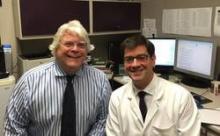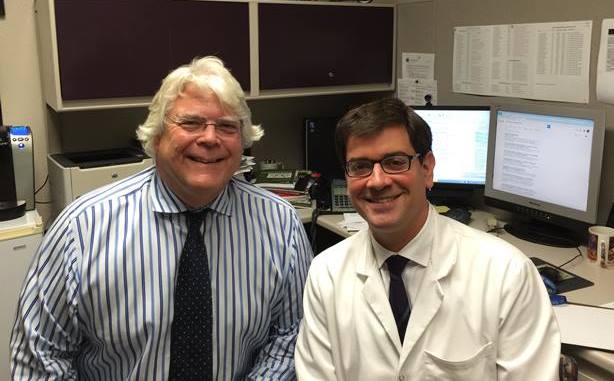User login
NEW YORK – Asynchronous telepsychiatry, labeled as a virtual mental health technology, has shown sufficient promise that it is being tested in a randomized trial, according to those instrumental in its development and the trial’s designers. The strategy was outlined at the American Psychiatric Association’s Institute on Psychiatric Services.
The technology, which involves videotaping structured interviews with patients that can be then reviewed by a psychiatrist at some later opportunity and is known as ATP, has demonstrated in pilot programs results in care that are as effective as synchronous, real-time teleconferencing, reported Dr. Lorin M. Scher of the department of psychiatry and behavioral sciences at the University of California, Davis.
The concept of ATP grew out of efforts to expand a collaborative care program that provides access to mental health care services at regional clinics associated with UC Davis. Real-time video conferencing, which allows psychiatrists to collaborate with primary care physicians and care managers to manage the mental health care needs of patients in remote clinics, is now used widely but has some limitations, Dr. Scher report
“You need to have a psychiatrist available at a particular time, you need the patient to come to the clinic at a particular time, and it is not as cost effective as one would like it to be,” Dr. Scher reported.
The ATP program at UC Davis, which is being led by Dr. Peter Yellowlees, involves an interview conducted by a trained care manager that is recorded, stored, and then viewed by a psychiatrist at a later time. Just as in synchronous consultations, the psychiatrist produces a full report with treatment recommendations. These are made available to the primary care physician and entered into the electronic medical record (EMR). The primary care physician is invited to contact the psychiatrist with subsequent questions or clarifications.
Synchronous telepsychiatry already has been shown to be effective in multiple studies, according Dr. Scher. Evaluations performed with teleconferencing permit psychiatrists to make accurate diagnoses valid for management recommendations. In the context of a collaborative care model, these recommendations have been associated with good quality care and outcomes. The hypothesis for the randomized trial is that asynchronous telepsychiatry will perform as well in this same model.
After enrollment and randomization to synchronous or asynchronous evaluation, “we plan to compare clinical outcomes, patient satisfaction, and cost over a period of 2 years,” Dr. Scher reported. Of the planned enrollment of 150 patients, 55 have already been randomized.
The technology to perform ATP is simple and widely available. Referrals are handled through the UC Davis EMR system. Once the interview is captured, it is transferred to the psychiatrist through a secure server. It is expected that videos will be eventually uploaded directly into the EMR. The reports generated by the psychiatrist are identical whether based on synchronous or asynchronous telemedicine.
The efforts at UC Davis to deliver mental health services through a collaborative care model are a response to the evidence that psychiatric disease is undertreated, particularly in clinics distant from tertiary care centers. Dr. Scher cited published studies suggesting that about 25% of patients visiting a PCP have a mental health complaint. Of those with mental illness, 60% of patients receive no treatment at all, and only 20% are treated by psychiatrists. He also cited evidence that inadequate control of psychiatric disorders like depression incur high costs attracting the attention of third-party payers to new ideas for delivery of cost-effective care.
“There is a lot of disparity in mental health services,” Dr. Scher said. “The question we are asking ourselves is: ‘How as psychiatrists do we spread our skills to serve a large population?’ ”
Telepsychiatry in the context of collaborative care is a model that is already working, Dr. Scher said. The randomized trial will determine whether the ATP variant can be added to synchronous videoconferencing as an equally effective tool.
Dr. Scher reported no relevant financial relationships.
NEW YORK – Asynchronous telepsychiatry, labeled as a virtual mental health technology, has shown sufficient promise that it is being tested in a randomized trial, according to those instrumental in its development and the trial’s designers. The strategy was outlined at the American Psychiatric Association’s Institute on Psychiatric Services.
The technology, which involves videotaping structured interviews with patients that can be then reviewed by a psychiatrist at some later opportunity and is known as ATP, has demonstrated in pilot programs results in care that are as effective as synchronous, real-time teleconferencing, reported Dr. Lorin M. Scher of the department of psychiatry and behavioral sciences at the University of California, Davis.
The concept of ATP grew out of efforts to expand a collaborative care program that provides access to mental health care services at regional clinics associated with UC Davis. Real-time video conferencing, which allows psychiatrists to collaborate with primary care physicians and care managers to manage the mental health care needs of patients in remote clinics, is now used widely but has some limitations, Dr. Scher report
“You need to have a psychiatrist available at a particular time, you need the patient to come to the clinic at a particular time, and it is not as cost effective as one would like it to be,” Dr. Scher reported.
The ATP program at UC Davis, which is being led by Dr. Peter Yellowlees, involves an interview conducted by a trained care manager that is recorded, stored, and then viewed by a psychiatrist at a later time. Just as in synchronous consultations, the psychiatrist produces a full report with treatment recommendations. These are made available to the primary care physician and entered into the electronic medical record (EMR). The primary care physician is invited to contact the psychiatrist with subsequent questions or clarifications.
Synchronous telepsychiatry already has been shown to be effective in multiple studies, according Dr. Scher. Evaluations performed with teleconferencing permit psychiatrists to make accurate diagnoses valid for management recommendations. In the context of a collaborative care model, these recommendations have been associated with good quality care and outcomes. The hypothesis for the randomized trial is that asynchronous telepsychiatry will perform as well in this same model.
After enrollment and randomization to synchronous or asynchronous evaluation, “we plan to compare clinical outcomes, patient satisfaction, and cost over a period of 2 years,” Dr. Scher reported. Of the planned enrollment of 150 patients, 55 have already been randomized.
The technology to perform ATP is simple and widely available. Referrals are handled through the UC Davis EMR system. Once the interview is captured, it is transferred to the psychiatrist through a secure server. It is expected that videos will be eventually uploaded directly into the EMR. The reports generated by the psychiatrist are identical whether based on synchronous or asynchronous telemedicine.
The efforts at UC Davis to deliver mental health services through a collaborative care model are a response to the evidence that psychiatric disease is undertreated, particularly in clinics distant from tertiary care centers. Dr. Scher cited published studies suggesting that about 25% of patients visiting a PCP have a mental health complaint. Of those with mental illness, 60% of patients receive no treatment at all, and only 20% are treated by psychiatrists. He also cited evidence that inadequate control of psychiatric disorders like depression incur high costs attracting the attention of third-party payers to new ideas for delivery of cost-effective care.
“There is a lot of disparity in mental health services,” Dr. Scher said. “The question we are asking ourselves is: ‘How as psychiatrists do we spread our skills to serve a large population?’ ”
Telepsychiatry in the context of collaborative care is a model that is already working, Dr. Scher said. The randomized trial will determine whether the ATP variant can be added to synchronous videoconferencing as an equally effective tool.
Dr. Scher reported no relevant financial relationships.
NEW YORK – Asynchronous telepsychiatry, labeled as a virtual mental health technology, has shown sufficient promise that it is being tested in a randomized trial, according to those instrumental in its development and the trial’s designers. The strategy was outlined at the American Psychiatric Association’s Institute on Psychiatric Services.
The technology, which involves videotaping structured interviews with patients that can be then reviewed by a psychiatrist at some later opportunity and is known as ATP, has demonstrated in pilot programs results in care that are as effective as synchronous, real-time teleconferencing, reported Dr. Lorin M. Scher of the department of psychiatry and behavioral sciences at the University of California, Davis.
The concept of ATP grew out of efforts to expand a collaborative care program that provides access to mental health care services at regional clinics associated with UC Davis. Real-time video conferencing, which allows psychiatrists to collaborate with primary care physicians and care managers to manage the mental health care needs of patients in remote clinics, is now used widely but has some limitations, Dr. Scher report
“You need to have a psychiatrist available at a particular time, you need the patient to come to the clinic at a particular time, and it is not as cost effective as one would like it to be,” Dr. Scher reported.
The ATP program at UC Davis, which is being led by Dr. Peter Yellowlees, involves an interview conducted by a trained care manager that is recorded, stored, and then viewed by a psychiatrist at a later time. Just as in synchronous consultations, the psychiatrist produces a full report with treatment recommendations. These are made available to the primary care physician and entered into the electronic medical record (EMR). The primary care physician is invited to contact the psychiatrist with subsequent questions or clarifications.
Synchronous telepsychiatry already has been shown to be effective in multiple studies, according Dr. Scher. Evaluations performed with teleconferencing permit psychiatrists to make accurate diagnoses valid for management recommendations. In the context of a collaborative care model, these recommendations have been associated with good quality care and outcomes. The hypothesis for the randomized trial is that asynchronous telepsychiatry will perform as well in this same model.
After enrollment and randomization to synchronous or asynchronous evaluation, “we plan to compare clinical outcomes, patient satisfaction, and cost over a period of 2 years,” Dr. Scher reported. Of the planned enrollment of 150 patients, 55 have already been randomized.
The technology to perform ATP is simple and widely available. Referrals are handled through the UC Davis EMR system. Once the interview is captured, it is transferred to the psychiatrist through a secure server. It is expected that videos will be eventually uploaded directly into the EMR. The reports generated by the psychiatrist are identical whether based on synchronous or asynchronous telemedicine.
The efforts at UC Davis to deliver mental health services through a collaborative care model are a response to the evidence that psychiatric disease is undertreated, particularly in clinics distant from tertiary care centers. Dr. Scher cited published studies suggesting that about 25% of patients visiting a PCP have a mental health complaint. Of those with mental illness, 60% of patients receive no treatment at all, and only 20% are treated by psychiatrists. He also cited evidence that inadequate control of psychiatric disorders like depression incur high costs attracting the attention of third-party payers to new ideas for delivery of cost-effective care.
“There is a lot of disparity in mental health services,” Dr. Scher said. “The question we are asking ourselves is: ‘How as psychiatrists do we spread our skills to serve a large population?’ ”
Telepsychiatry in the context of collaborative care is a model that is already working, Dr. Scher said. The randomized trial will determine whether the ATP variant can be added to synchronous videoconferencing as an equally effective tool.
Dr. Scher reported no relevant financial relationships.
EXPERT ANALYSIS FROM INSTITUTE ON PSYCHIATRIC SERVICES

